Why Baseball Card Packs No Longer Include Sticks Of Bubble Gum
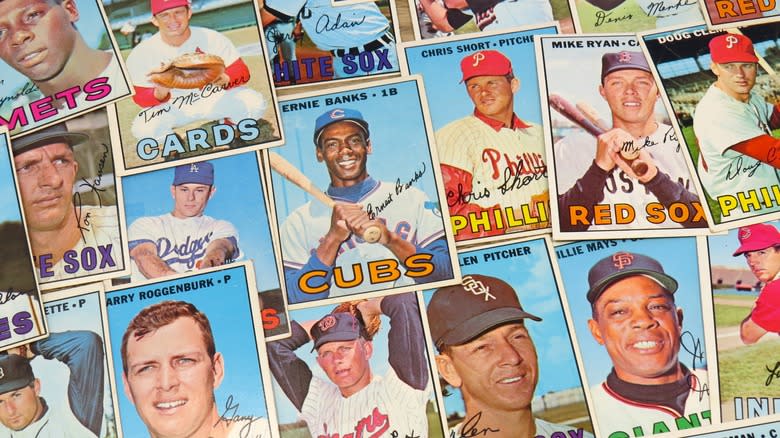
Anyone ripping into a new pack of baseball cards during the mid-to-late 20th century was likely to get an additional "bonus" that may or may not be worthy of the name – a slab of mediocre bubblegum. By the early '90s, though, baseball card bubblegum was a thing of the past. Why did all of the different card manufacturers stop including the stuff?
Well, the answer may be twofold. For one thing, by that point in time, baseball cards were well-established as a potentially valuable collectible purchased by grownups, not just something for kids to swap or stick in the spokes of their bike wheels. There was no longer a need to induce adults to purchase them by including free (and not particularly good) candy, so why should the card companies bother? Especially in light of the fact that they had a pretty powerful disincentive to keep putting gum in the card packs, as collectors were complaining about stains left on the cards that came in contact with the gum.
Read more: US Foods You Surprisingly Can't Find In Canada
When Did Baseball Card Manufacturers Start Including Gum?
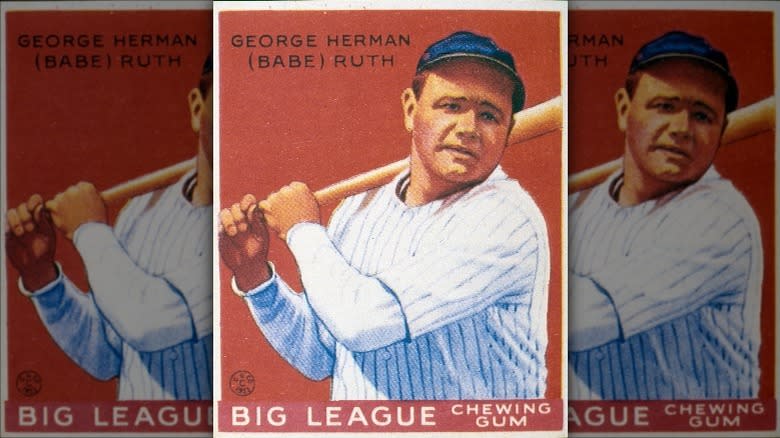
Interestingly enough, the first time that baseball cards and gum were packaged together, the cards themselves weren't the main attraction. Instead, back in the 1930s, baseball cards were seen as something that would entice kids to favor one particular brand of gum over another. Two of the original baseball card manufacturers, in fact, were gum companies. Fleer, the same people who brought us Dubble Bubble, stayed in the baseball card game until 2005 when its operation was bought out by Upper Deck, although it still releases basketball cards (sans gum) under the Fleer name. Goudey, however, was out of the bubblegum-making and baseball card businesses by 1962.
Topps is a name that pretty much defines baseball cards today, despite having been bought out by sports merch conglomerate Fanatics in 2022. Ironically, the company was actually one of the last candy makers to jump on the card train back in 1951. The first year's release didn't get off to a great start since the finish was said to smell like kerosene while the taffy that was included in place of gum picked up this flavor. By 1952, however, Topps switched to using bubblegum and apparently came up with a less-stinky card coating.
Both Baseball Cards And Gum Have Had Other Partners
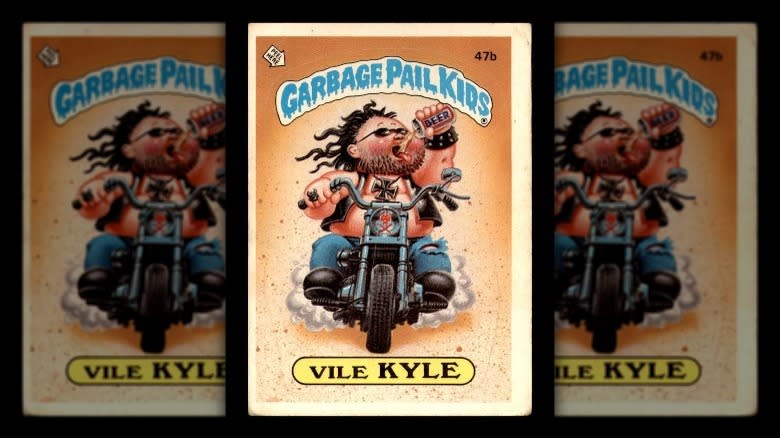
While baseball cards and bubblegum were a peanut butter and jelly pairing for many years, this was actually a second-chance romance for sports cards. The very first ones printed up were included with cigarette packs in the late 1800s, while by the turn of the century baseball cards were included in boxes of Cracker Jack (a snack that's long been associated with the sport).
Non-baseball-themed trading cards, too, have been packaged with sticks of bubble gum. Topps' first card featured a portrait of Hopalong Cassidy, a character who'd featured in over 60 movie westerns by that time. The company continued to release TV and movie-themed cards over the years, including Teenage Mutant Ninja Turtles cards in the '80s.
That decade also saw Topps release its infamous Garbage Pail Kids cards, a deliberate middle finger to the company that made Cabbage Patch Kids dolls since it didn't want to do business with Topps. GPK cards were considered pretty controversial back in the day, with undersea explorer Jacques Cousteau feeling that exposure to their violent imagery would lead to drug addiction and Andy Warhol, uncle of card illustrator James Warhola, finding them both compelling and repellent. One thing that can't be denied, though, is that the cards were one hell of an investment. In 1985 25 cents bought you 5 cards and a stick of gum, but today those highly collectible originals sell for thousands of dollars.
When Was Gum In Card Packs Phased Out?
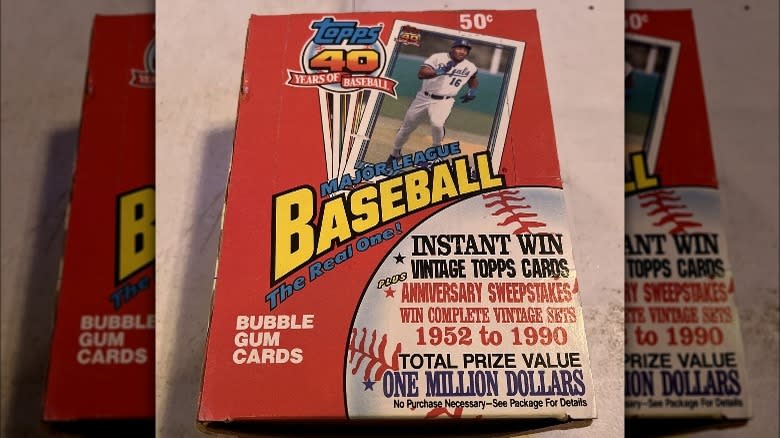
By 1991, there were a number of different baseball card manufacturers, but Topps was the only one still including gum in its card packets after the 1981 overturn of an antitrust lawsuit that claimed the company was monopolizing the trading card market. While it could not restrict companies like Fleer from selling cards, it did manage to hang on to the exclusive right to package them with gum. Once Topps pulled the plug on gum inclusions nine years before the turn of the millennium, that marked the end of an era.
Collectors may have been pleased that their cards would no longer be stained with gum residue, but not everyone was quite so pleased by the decision. Topps spokesman Timm Boyle, who characterized the move as a "difficult decision," told the Chicago Tribune that he himself had fond memories of buying baseball cards packaged with gum. As he reminisced, "It was a very nice experience - the waxy paper, and the cards inside, and the smell of the gum.'' In fact, as he admitted, ''The gum was one of the reasons you would buy the cards in the first place." The Tribune, too, was unable to report on the announcement with strict journalistic objectivity as it repeatedly referred to the card collectors who'd forced such a move as "dweebs" and characterized them as money-grubbers determined to kill off the magic of card collecting.
Topps Brought Back Baseball Card Gum In A Limited Edition
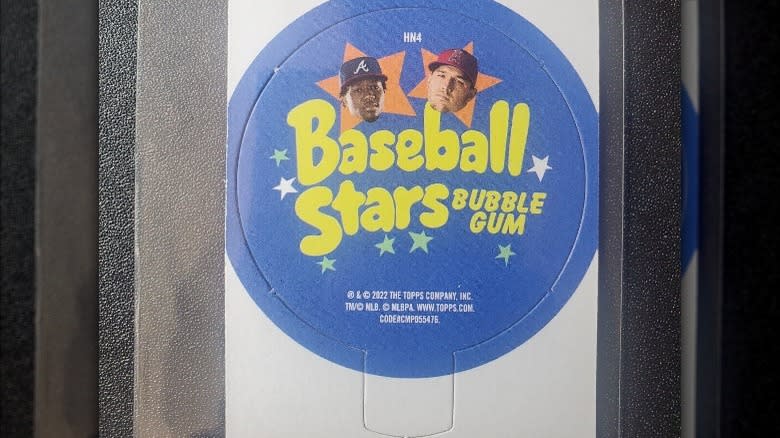
1991 was the last time that you'd be able to find bubble gum in any random pack of (Topps-branded) baseball cards that you bought at the drugstore, but it wasn't quite the last hurrah for baseball card bubble gum. In 2001, Topps included bubble gum in its Heritage Collection, although the gum came wrapped in plastic to avoid staining the cards.
It seems as if Topps may have included gum in its Heritage Collection cards at least through 2010. By 2015, however, the cards instead sported bubble gum-scented scratch 'n' sniff faux gum stains. In more recent years, 2022 Topps Heritage cards came with what was termed a bubblegum insert, but this looks like it's made of cardboard so it's unclear as to what the gum tie-in may be. It also does not appear as if the 2023 Heritage boxes feature these bubblegum inserts or, indeed, anything gum-themed because there is no mention of this on Topps' website.
What Did Baseball Card Gum Taste Like?
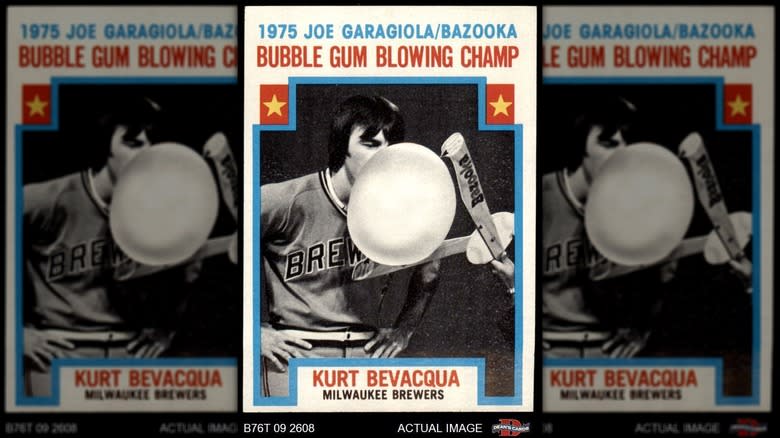
If you were able to experience baseball card gum back when it was fresh, your experience may have varied from pack to pack. Some have lauded the gum as sweet and tasty, while others remember the flavor less fondly, but one factor at play may have been how long the cards sat on the store shelf. The way many recall it, there's a chance that the gum was already stale and crumbly by the time you opened the pack. When Topps brought back the gum for its Heritage series in the '00s, the candy hadn't improved at all. While the nostalgia may have been sweet, the bubblegum itself was said to be pretty bad - insufficiently chewy and with a weird chemical aftertaste.
A few brave souls have ventured to eat sticks of gum that have been sitting in card packs since 1991 (or earlier). Needless to say, no rave reviews for this stuff. The general consensus seems to be that it crumbles to dust in your mouth and tastes, unsurprisingly, of cardboard. The good news, though, is that if you ever come across a stick of well-aged gum and decide to try the experiment yourself, it should be perfectly safe. While antique bubblegum is hardly going to make your tastebuds dance with delight and inspire you to pen poetic praise, it's also unlikely to make you ill as it's one of those foods that never really expire.
Read the original article on Mashed.

